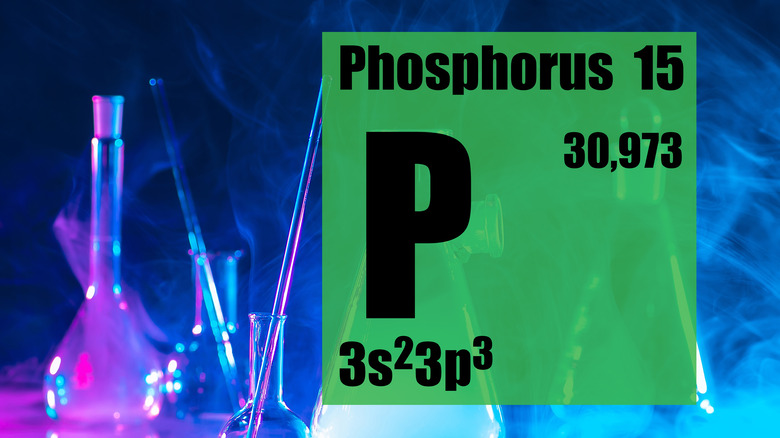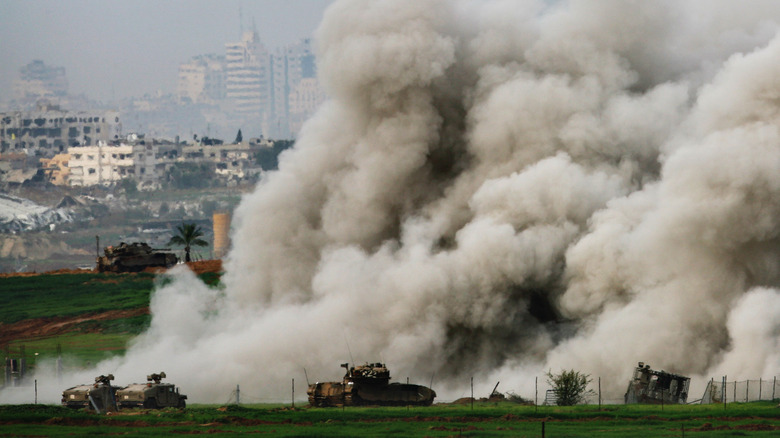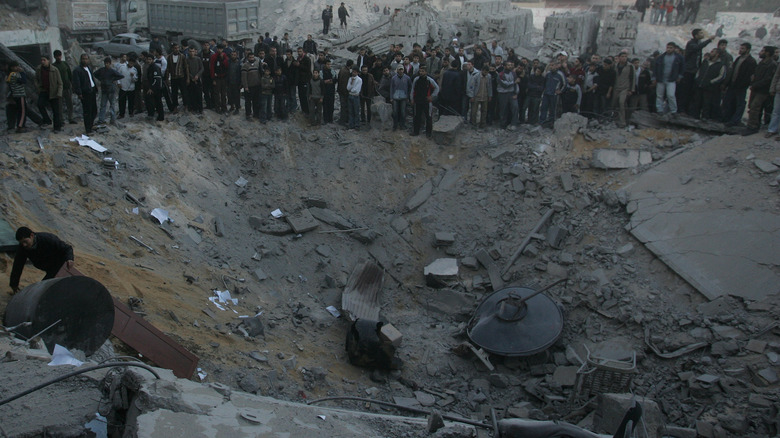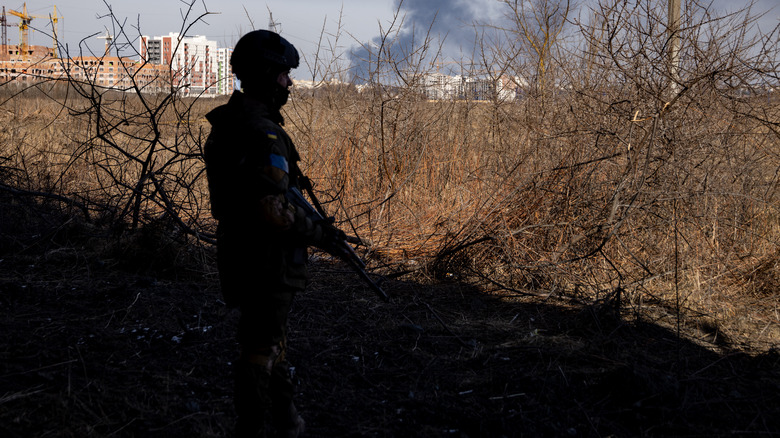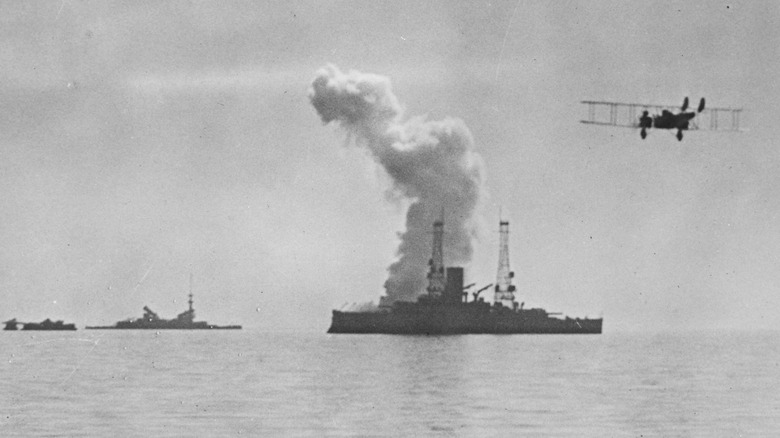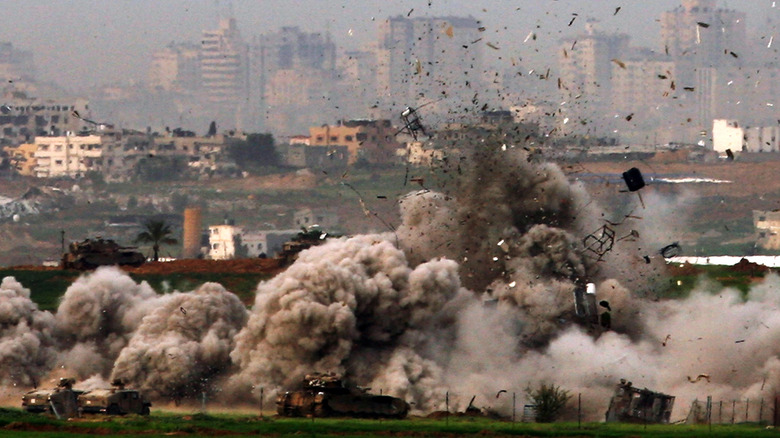What Are Phosphorus Bombs And What Do They Do?
On March 24, Ukrainian President Volodymyr Zelenskyy announced that Russia had used phosphorus bombs in its latest attack in Ukraine (via NBC News). Per The National Post, this brought up valid concerns that Russia could eventually deploy chemical and nuclear weapons as the war rages on. Phosphorus bombs are not to be taken lightly. The Guardian explains that there are two forms of phosphorus: red and white. Red is nontoxic, but the same cannot be said for white phosphorus. Human Rights Watch reports that when white phosphorus is used as a weapon, the injuries caused to humans, structures, and land are grievous.
According to the American Chemical Society, white phosphorus was discovered in 1669 by German alchemist Hennig Brandt. He was attempting to create the famed philosopher's stone by boiling down 1,200 gallons of urine over the course of a few weeks (per Science History Institute). Instead, he produced a bright white vapor that he coined as phosphorus. It was eventually used in matches, fertilizer, and as poison. However, within 100 years of its unearthing, it was being used in bombs. When combined with minerals instead of urine, it becomes an incendiary substance. In other words, it transforms into a highly flammable and deadly material.
The science behind phosphorus bombs
The National Post writes that white phosphorus is currently manufactured by using phosphate found in rocks. When phosphate rock is heated with carbon and silica, white phosphorus is created (via the Royal Society of Chemistry). Global Security reports that phosphate rock can be found throughout the United States and Russia. White phosphorus itself is described as being a white or yellow waxy-like substance that smells of garlic. Within seconds of coming into contact with oxygen, it catches on fire. The Guardian explains that it produces opaque smoke that can be used as a smokescreen. This can obstruct enemy views and more.
When used as a bomb or in other munitions to attack civilians, Human Rights Watch classifies it as an incendiary weapon. NBC News describes this as fires and burns caused "through the action of flame, heat, or combination thereof, produced by a chemical reaction of a substance delivered on the target." According to Marca, white phosphorus can be used in various ways, including in rockets and grenades. To say the results are devastating is an understatement. It causes burns, death by smoke inhalation, and more. This is because the particles continue to burn until there is no oxygen left. Ultimately, exposure can cause death within 24 to 48 hours.
The horrific injuries caused by phosphorus bombs
According to Human Rights Watch, white phosphorus is notorious for the crippling physical and mental injuries it causes humans. The National Post writes that once it comes into contact with skin, it instantly begins to burn and can expose the bone, as the substance is soluble in fat (via NBC News). If the particles are not completely removed during treatment, it can continue to burn when exposed to oxygen. According to the Agency for Toxic Substances and Disease Registry, if the smoke from white phosphorus is inhaled for a short period, the throat and lungs will become irritated. If it's inhaled for an extended amount, the jaw bone can start to break down.
Injuries from incendiary weapons are almost always fatal. But if one survives, they can expect a number of long-term effects. This can include chronic pain, scars, psychological anguish, and a number of other devastating disabilities. In brief, the victim will most likely never have a normal life again. Erik Tollefsen from the International Committee of the Red Cross told Newsweek, "I've seen these burns first-hand when trying to assist and provide first aid to the victims of these attacks and it's devastating ... It burns deep, deep, deep into the body and the trauma it causes can be severe."
The alleged use of phosphorus bombs in Ukraine
In an emergency meeting with NATO in March 2022, President Zelenskyy stated, "This morning, by the way, there were phosphorus bombs. Phosphorus Russian bombs. Adults were killed again and children were killed again" (via The National Post). NBC News reports that Zelenskyy did not provide proof for the reported use of these phosphorus bombs. Additionally, U.S officials were also unable to confirm his claims. However, Democracy Now writes that a British Channel, ITV, captured video footage of what appears to be white phosphorus' signature bright light over the city of Irpin. This is not the first time Russia has been accused of using white phosphorus munitions.
The Independent explains that it's believed that white phosphorus has also been recently used in other Ukrainian cities, including Kramatorsk, Lutsk, and Popasna. This news comes as President Biden recently stated that he believed the use of chemical weapons in Ukraine was a "real threat" (per Sky News). As for Russia, they have denied (per the Moscow Times) that they used phosphorus bombs. However, according to the Russian news agency Tass, Chechnya leader Ramzan Kadyrov has accused Ukraine of using white phosphorus and endangering their own people. Per ABC News, Russia has also recently been accused of using thermobaric weapons, which cause high-temperature explosions, and purposefully targeting civilians, including a maternity ward.
Phosphorus bombs have been used for decades
According to The Times of India, white phosphorus was first extensively used as a weapon during World War I, and again during World War II. Since then, it has been utilized in various conflicts, including in Vietnam and Korea. Furthermore, it's believed Russia used white phosphorus during the first and second Chechen wars (via India Times). As explained by The National Post, it has been primarily used by the U.S. and the U.K. in recent years in Syria and Afghanistan. Known in the U.S. as "Whiskey Pete," white phosphorus was used by Marines in Fallujah, a city in Iraq, as Reuters reported in 2009.
Human Rights Watch reported that Israel used the weapons in Gaza between 2008 and 2009. They later vowed to stop using white phosphorus (per the BBC). Per NBC News, Saudi Arabia used it in Yemen in 2016, while Ethiopia used it against Somalia in 2007. Additionally, Syria used white phosphorus against its own people during their civil war. Hamish de Bretton-Gordon from NATO's chemical, biological and nuclear defense forces stated that he viewed "horrendous images from northeast Syria last year of children being terribly, badly burned." Ultimately, Ukrainian officials believe that Vladimir Putin wants to imitate Syrian techniques (which he supported) in Ukraine (via Marca).
The use of white phosphorus has not been banned
Despite its severe implications, NBC News writes, white phosphorus is not illegal. However, it is illegal to use as a weapon against ordinary citizens. Simply put, it's not an issue if a country produces or uses white phosphorus as an obscurant, as long as it stays that way (via Yahoo! News Australia ). This is due to the 1983 Convention on Certain Conventional Weapons (per Barron's Magazine). Ultimately, this restricted the use of white phosphorus but did not prohibit it.
As explained by Human Rights Watch, this is because white phosphorus has various militaristic uses (like illuminating war zones and use as smoke signals) that are not intended to kill civilians. For this reason, as Newsweek reports, it's often difficult to classify the use of phosphorus bombs and other white phosphorus munitions as war crimes. This loophole has essentially enabled various countries to get away with crimes against humanity.
Since the use of white phosphorus in Fallujah by the U.S. (per Independent), the city has seen increases in cancer and infant death. Another example is Israel; they stated they used white phosphorus strictly as a smoke screen but that it inadvertently caused the deaths of thousands (via the BBC). Despite this, military expert David E. Johnson has gone on to say that "Going after civilian targets indiscriminately is the biggest war crime there is, no matter what the weapon."
